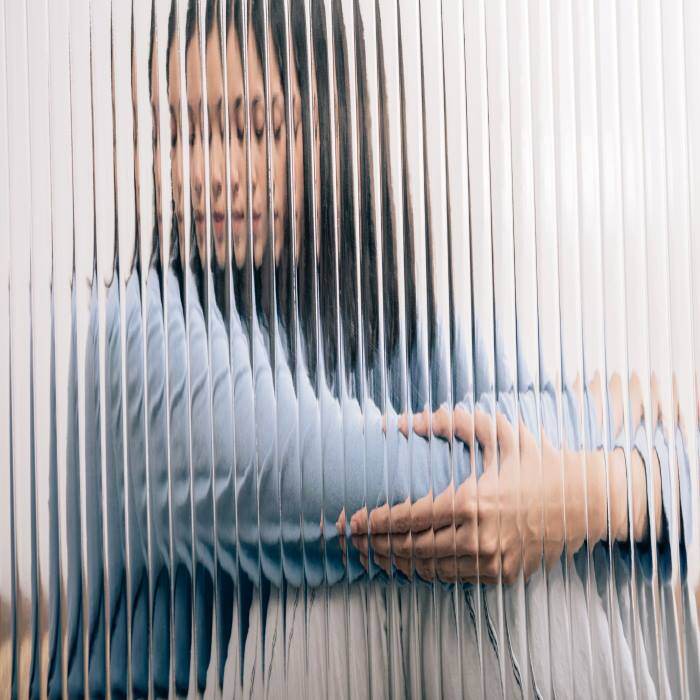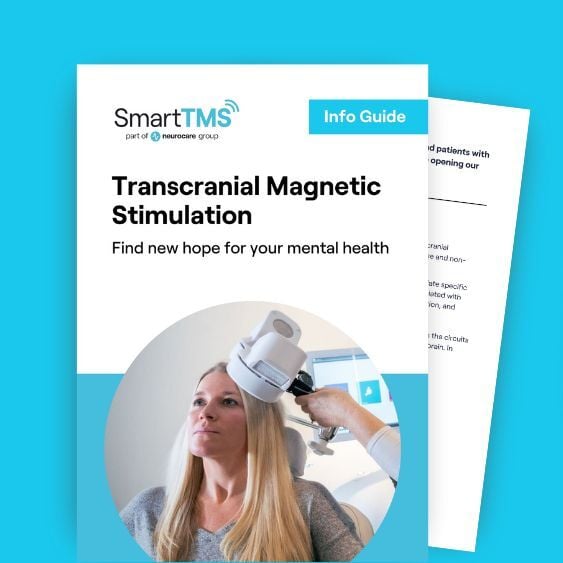Efficacy, Effectiveness and Success Rates of TMS Depression Treatment
January 1, 2025 - Smart TMS

What Are the Different Depressive Disorders?
Depression is a debilitating psychological disorder that has seven primary clinical presentations according to the DMS-5:
- Disruptive mood dysregulation disorder
- Major depressive disorder
- Persistent depressive disorder (formerly dysthymia)
- Premenstrual dysphoric disorder
- Substance/medication induced depressive disorder
- Depressive disorder due to another medical condition
- Unspecified Depressive Disorder
While any of these seven distinct disorders may underlie a depressed mood, major depressive disorder (MDD) and persistent depressive disorder (PDD) are the two most common presentations of depression and the two disorders that are most heavily associated with the broad term of “depression”.
Both MDD and PDD are characterised by the following symptoms:
- Depressed mood
- Sleep issues
- Restlessness or irritability
- Difficulty concentrating
- Feelings of hopelessness or suicidal ideation
- Feelings of worthlessness or low self-esteem
- Low energy or anhedonia
One of the main differences between these two disorders lies in the duration of the conditions as MDD persists for at least 2 weeks, whereas PDD persists for at least 2 years (DSM-5). While the symptoms of PDD persist for longer they do tend to be milder in severity when compared to MDD.
Treatment for Depression
There are many different treatments available for clinical, as well as subclinical, depression. However, different presentations may have specific treatments that are most effective in reducing symptom severity. The most common treatments for depressive disorders or depressed mood in general include:
- Medication
- Talk therapy
- Exercise
- Positive lifestyle changes
- Sleep hygiene interventions
- Occupational therapy
- Improved diet
- Transcranial Magnetic Stimulation (TMS) treatment
From Discovery of TMS to Treatment of Depression
Transcranial Magnetic Stimulation (TMS) was first developed in 1985 by Anthony Barker, and for many years it was utilised as a research tool to noninvasively target specific sites of the cortex before its utility as a therapeutic intervention was realised (Hamlin & Garman, 2023). It received FDA approval as a treatment tool for depression in 2008 and NICE also gave TMS the green light for treatment of depression in 2015.
TMS Depression Studies
In the past 4 decades, a plethora of TMS depression studies have been carried out to determine the efficacy of TMS treatment for depression. For a study to be considered valid, it needs to include a test group (the group that is given the treatment in question) and a control group (a group merely used as a baseline by which to compare the test group). Some TMS depression research will go a step further and include a group that is given sham treatment (TMS sessions that do not have any therapeutic power) which effectively act as a placebo group. These placebo (or sham treatment) groups allow researchers to control for the placebo effect (i.e. when people believe that they are receiving treatment they will often spontaneously improve regardless of the effectiveness of the treatment). As such the inclusion of a sham treatment group in a TMS depression study allows a more stringent assessment of the efficacy of TMS as a treatment for depression.
TMS Depression Evidence
Gaynes et al. (2014) utilised a sham treatment controlled study when attempting to determine the efficacy of rTMS as a treatment for depression (MDD specifically). They reported that patients receiving genuine TMS were more than 3 times more likely to respond than those receiving sham treatment. Furthermore, the treatment group sustained a meaningfully significant reduction in their depressive symptoms as measured by the Hamilton Depression Rating Scale (HDRS). Most impressively, the samples utilised for this study comprised patients who had displayed a resistance to at least two different antidepressants. This evidences TMS as an effective treatment for depression even in treatment resistant cases.
Rizvi & Khan (2019) undertook a review of the literature and found that several randomised controlled trials reported remission rates of 30% to 40% when treating depressive symptoms by administering TMS over the left prefrontal cortex. Furthermore, they noted that a large multicenter randomised trial found the remission rates associated with TMS treatment to be four times higher than placebo in depression patients. In conclusion, the results of the TMS depression studies considered in this review indicate that it is a highly effective treatment for individuals suffering with depression, especially those with treatment resistant cases.
MDD versus PDD in TMS Depression Research
It appears the majority of the evidence indicating that TMS is effective in treating depression either uses samples diagnosed with major depressive disorder (MDD) or does not specify diagnosis regarding their samples.
A recent study attempted to ascertain if comorbidities have an impact on treatment results and concluded that patients are equally as likely to respond to TMS treatment if suffering from MDD or PDD (Nassan et al., 2020). Taking this finding, one could assume that the success rate of TMS treatment for depression is potentially uniform regardless of the specific condition (MDD or PDD).
Efficacy of TMS and Supplementary Depression Treatments
TMS has been shown to be even more successful in treating depression when combined with supplementary treatment. The results of Cruz et al. (2023) showed a response of 91% in a treatment resistant cohort of depression patients who were given TMS treatment in conjunction with a CBT as well as a nutrition intervention. This finding was further supported by Dalhuisen et al. (2023) who demonstrated that a combined intervention of TMS and CBT is 3 times more effective at eliciting a response and 7 times more effective at achieving remission than a combined intervention of CBT and antidepressants. It would appear that talk therapy combined with TMS treatment yields the most impressive depression treatment success rate.
Smart TMS Depression Results
At Smart TMS, our in-house analyses are a good measure of the effectiveness of TMS depression treatment, as the samples we use are derived from anonymized patient records. This means our results are generated from real world examples rather than clinical trials which allows us to comment on the effectiveness of treatment rather than its efficacy.
We took a sample of 361 patients who received rTMS treatment for depression and analysed their PHQ-9 scores (a psychometric that measures depressive symptoms). We found that 2 out of 3 patients showed a significant response to treatment. Moreover, half of the patients in the sample achieved remission (we defined remission as no longer meeting the clinical threshold for a diagnosis of depression according to one’s PHQ-9 score). Additionally, more than 1 in 5 patients showed a near-complete resolution of their depressive symptoms (again this was determined by a patient’s PHQ-9 score).
Our results reflect the TMS depression studies results that are found in the literature and indicate that TMS is an effective treatment for depression. However, for the best results one should combine their TMS treatment with supplementary treatments such as CBT, or positive lifestyle changes.
Written by Joe, Smart TMS Dublin Practitioner
Bibliography
- Cruz, J., Reyes, L., Cruz I., Bossano F., (2023) Nutrition + CBT + TMS: an integrative approach for depressive and anxiety symptoms for treatment-resistant depression (TRD) patients., Brain Stimulation, Volume 16, Issue 4, Page 7, ISSN 1935-861X
- Gaynes BN, Lloyd SW, Lux L, Gartlehner G, Hansen RA, Brode S, Jonas DE, Swinson Evans T, Viswanathan M, Lohr KN. (2014) Repetitive transcranial magnetic stimulation for treatment-resistant depression: a systematic review and meta-analysis. J Clin Psychiatry; 75(5):477-89; quiz 489. doi: 10.4088/JCP.13r08815. PMID: 24922485.
- Hamlin, D., & Garman, J., (2023) A Brief History of Transcranial Magnetic Stimulation American Journal of Psychiatry Residents’ Journal Volume 18, Number 3
- Dalhuisen, I., Smit, F., Spijker, J., van Oostrom, I., van Exel, E., van Mierlo, H., de Waardt, D., Arns, M., Tendolkar, I., van Eijndhoven, P., (2023) rTMS combined with CBT as a next step in antidepressant non-responders: a randomized comparison with current antidepressant treatment approaches, Brain Stimulation, Volume 16, Issue 1, Page 179, ISSN 1935-861X,
- Nassan, M., Hu, Y., Kung, S., Croarkin, P., (2020) Psychiatric comorbidities did not influence remission and response rates in patients treated with transcranial magnetic stimulation (TMS) for major depressive disorder, Brain Stimulation, Volume 13, Issue 6, Pages 1851-1852, ISSN 1935-861X
- NICE (2015) Repetitive transcranial magnetic stimulation for depression Overview | Repetitive transcranial magnetic stimulation for depression | Guidance | NICE
- Rizvi S, Khan AM. (2019) Use of Transcranial Magnetic Stimulation for Depression. Cureus. 23;11(5):e4736










